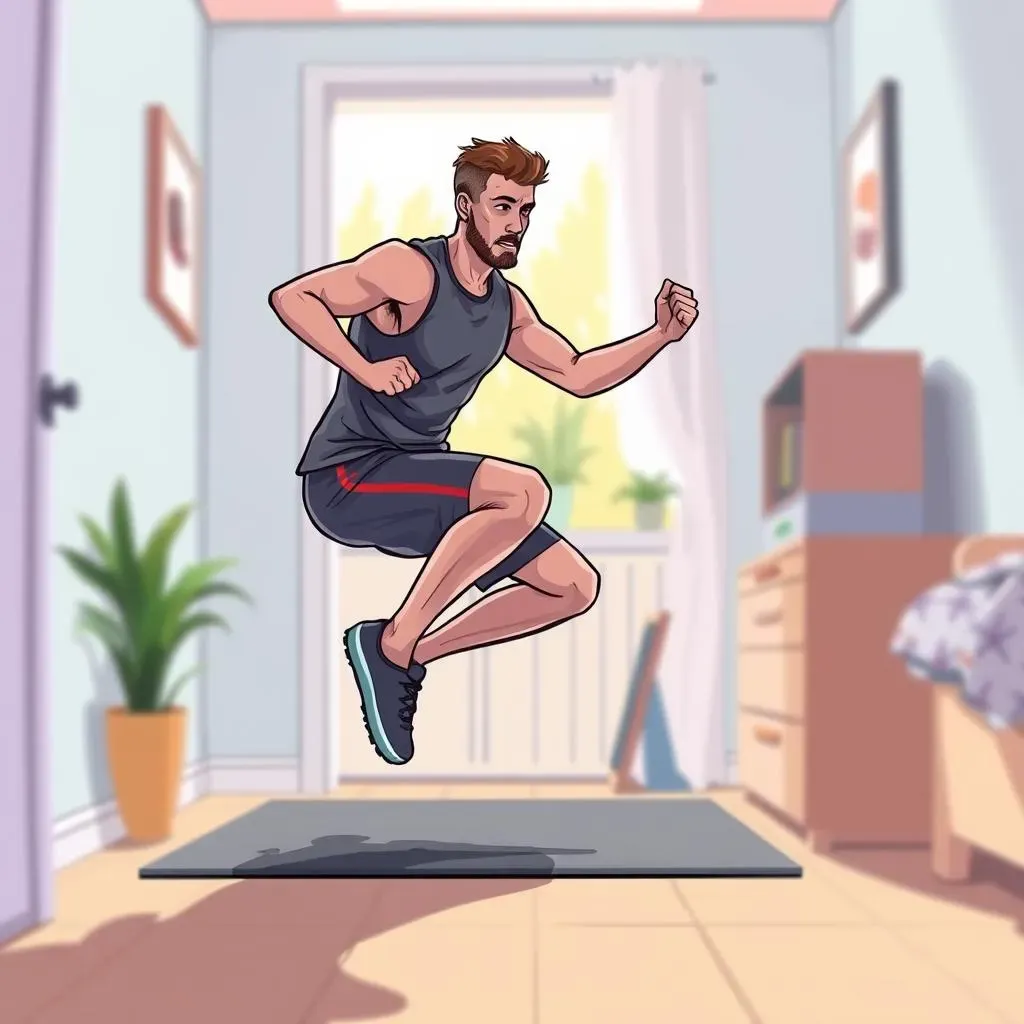Table of Contents
Let's face it: finding time and space for a proper workout can feel like a Herculean task, especially if you're short on both. But what if I told you that achieving a fantastic cardio workout is entirely possible, even within the confines of your compact living space? This article is your guide to conquering those fitness limitations. We'll explore effective cardio workouts at home in small spaces, focusing on exercises that require zero equipment and minimal room. Prepare to discover a range of dynamic movements that will get your heart pumping and torch calories without needing a gym membership or vast expanses of floor space. You'll learn how to maximize your limited area with smart workout strategies, boost your intensity without extra equipment, and stay motivated while avoiding common injuries. Ready to transform your apartment into your personal fitness sanctuary? Let's get started!
Cardio Workouts at Home in Small Spaces: Top 5 NoEquipment Exercises

Cardio Workouts at Home in Small Spaces: Top 5 NoEquipment Exercises
Jump Squats: A Full-Body Blast
Jump squats are a fantastic way to get your heart rate up quickly. They're deceptively simple – you stand with your feet shoulder-width apart, squat down as if sitting in a chair, and then explode upwards into a jump. Land softly, absorbing the impact through your legs and core. Remember to keep your back straight and engage your core throughout the movement. Start with 10-15 reps, and build up to three sets as you get fitter. It's a total body workout, building both strength and cardiovascular fitness. You can even add a little twist to make it more challenging: try jumping and turning 90 degrees with each jump.
The beauty of jump squats is their versatility; you can easily adjust the intensity by changing the height of your jump or adding a pause at the bottom of the squat. For a more intense workout, try adding weights (even filled water bottles will work!). And remember, proper form is crucial to avoid injury. If you're new to exercise, start slowly and gradually increase the number of reps and sets.
Exercise | Sets | Reps | Rest |
|---|---|---|---|
Jump Squats | 3 | 10-15 | 60 seconds |
High Knees: Running in Place, Amplified
High knees are another fantastic cardio exercise that needs no equipment and minimal space. Imagine you're running in place, but instead of bringing your knees to a normal running height, bring them up towards your chest. Keep your arms pumping to maintain momentum and engage your core. Aim for a quick tempo, maintaining a steady rhythm. Start with 30 seconds of high knees, followed by a 30-second rest. Repeat this for at least three rounds. You'll feel the burn in your quads and glutes, and your heart rate will definitely climb!
To make high knees more challenging, try adding a slight jump with each knee lift. You can also focus on the speed and height of your knee lifts to increase the intensity. Remember that consistency is key – even short bursts of high-intensity exercise can yield significant results. It's all about building up your stamina over time. Don't feel disheartened if you can't do many sets at first. Listen to your body and gradually increase the duration and intensity.
- Warm-up for 5 minutes before starting.
- Perform 3 sets of 30 seconds of high knees, with 30 seconds rest between sets.
- Cool down with 5 minutes of stretching.
Maximize Your Tiny Space: Smart Workout Strategies for Cardio

Maximize Your Tiny Space: Smart Workout Strategies for Cardio
Maximize Your Tiny Space: Smart Workout Strategies for Cardio
So, you're thinking, "Great exercises, but my apartment's smaller than a postage stamp!" Don't worry, my friend, we've got this. The key to maximizing your tiny space for cardio is strategic planning and smart exercise selection. Forget sprawling yoga mats and elaborate equipment setups. We're talking about maximizing efficiency and minimizing wasted movement. Think vertical space! Use your walls for support during exercises like wall sits (a killer leg workout!), or incorporate stair climbing if you're lucky enough to have them. Even a small space allows for creative movement. Consider circuit training, which involves performing a series of exercises back-to-back with minimal rest – this keeps your heart rate up and maximizes calorie burn in the shortest amount of time. Remember, it's not about the size of the space, it's about the intensity of your workout!
Another fantastic tip is to use furniture strategically. A sturdy chair can be used for step-ups, adding a dynamic element to your routine. The edge of a couch or a sturdy coffee table can be a great place to perform tricep dips, engaging your upper body while keeping your lower body active. Remember, safety first! Make sure your furniture is stable and won't tip over during your workout. And don't forget the power of bodyweight exercises. These are incredibly effective, requiring nothing but you and your own bodyweight. Think push-ups, burpees, mountain climbers—all amazing cardio workouts that fit into any space!
Strategy | Description | Benefits |
|---|---|---|
Circuit Training | Perform multiple exercises consecutively with minimal rest. | Maximizes calorie burn, increases heart rate efficiently. |
Vertical Space | Utilize walls or stairs for support or added challenge. | Adds variety, targets different muscle groups. |
Furniture Integration | Use stable furniture (chairs, couches) for step-ups or dips. | Improves strength training alongside cardio. |
"The body achieves what the mind believes." - Napoleon Hill. This applies perfectly to maximizing your small space workout. Believe in your ability to adapt and overcome, and you will see amazing results.
Remember to always listen to your body and adjust the intensity of your workout accordingly. If you feel any pain, stop immediately and consult a healthcare professional. Consistency and proper form are more important than pushing yourself too hard too soon.
- Plan your workout in advance.
- Choose exercises that suit your space and fitness level.
- Warm up before and cool down after each workout.
- Stay hydrated!
Cardio Workouts at Home in Small Spaces: Boosting Intensity Without Equipment

Cardio Workouts at Home in Small Spaces: Boosting Intensity Without Equipment
Plyometrics: Exploding Your Way to Fitness
Ready to take your cardio to the next level? Plyometrics are your secret weapon! These explosive exercises focus on rapid bursts of power, engaging your muscles in a way that traditional cardio just can't match. Think jump squats (we covered those earlier!), but also add in things like box jumps (if you have a sturdy box or step), lateral bounds (jumping sideways), and even simple jump lunges. The key here is to focus on the explosive movement – the quick, powerful push-off from the ground. Plyometrics not only boost your cardiovascular fitness but also build incredible strength and power. Remember to land softly, absorbing the impact with your legs and core to prevent injury.
Start slowly, mastering the form of each exercise before increasing the intensity or reps. You can even incorporate plyometric variations into your existing routine; for example, instead of a regular squat, try a jump squat. Remember, consistency is key. Even short bursts of plyometric exercises can make a huge difference over time. Don't be afraid to experiment and find variations that you enjoy – the goal is to find a routine that keeps you motivated and engaged.
Plyometric Exercise | Sets | Reps | Rest |
|---|---|---|---|
Jump Squats | 3 | 10-12 | 60 seconds |
Lateral Bounds | 3 | 10 per leg | 60 seconds |
Interval Training: Short Bursts, Big Results
Interval training is a game-changer for small-space cardio. It's all about alternating between high-intensity bursts of exercise and periods of rest or lower-intensity activity. For example, you might sprint in place for 30 seconds, followed by 30 seconds of walking in place, and repeat this cycle for 10-15 minutes. You can adapt this to any exercise; you could do high-knee intervals, jump squat intervals, or even burpee intervals. The key is to push yourself hard during the high-intensity periods and allow for adequate recovery during the rest periods. This method is incredibly effective for improving cardiovascular fitness and burning calories.
The beauty of interval training is its adaptability – you can adjust the intensity and duration of the intervals to suit your fitness level. Start with shorter intervals and gradually increase the duration as you get fitter. You can also use a timer or fitness app to help you keep track of your intervals. Remember, the goal is to push yourself to your limits during the high-intensity periods and then recover fully during the rest periods. This method is highly effective and efficient, making it perfect for small spaces and short time constraints. And remember to listen to your body!
- Warm up for 5 minutes.
- Perform 30 seconds of high-intensity exercise, followed by 30 seconds of rest or low-intensity exercise.
- Repeat for 10-15 minutes.
- Cool down for 5 minutes.
Adding Resistance: Boosting the Challenge
Think you need weights to really challenge your muscles? Think again! You can easily increase the intensity of your small-space cardio workouts without any extra equipment by simply modifying the exercises themselves. For example, instead of regular jump squats, try adding a small jump at the top of each squat, or try holding a plank while performing leg lifts. Adding a slight pause at the bottom of the squat or at the top of a jump can also increase the resistance. You can also incorporate exercises that naturally increase resistance, such as mountain climbers (bringing your knees to your chest increases resistance), or performing burpees with a push-up. The key is to focus on proper form and gradually increase the difficulty.
Remember to listen to your body and don't push yourself too hard, especially when starting. The goal is to gradually increase the intensity and challenge yourself while maintaining proper form to prevent injury. By incorporating these resistance-building modifications, you can transform your small-space cardio routine into a powerful, effective workout that delivers incredible results. And the best part? It all happens in the comfort of your own home! So get ready to push your limits and see just how strong you can become.
Small Space Cardio Workouts: Maintaining Motivation and Avoiding Injury

Small Space Cardio Workouts: Maintaining Motivation and Avoiding Injury
Staying Motivated in Your Mini-Gym
Let's be honest, staying motivated when your workout space is the size of a walk-in closet can be tough. The key is to make it fun! Create a playlist of your favorite upbeat tunes—music is a proven motivator. Consider turning your workout into a game, challenging yourself to beat your previous performance each time. Maybe even try a fitness app that offers gamified challenges or virtual classes. These can provide a sense of community and accountability, pushing you to stick to your routine. Remember, even small victories deserve celebration! Treat yourself to something you enjoy after a particularly challenging workout—a healthy snack, a relaxing bath, or a good book. The reward system will keep you coming back for more.
Another great strategy is to find a workout buddy, even if it's just a virtual one. Many fitness apps allow you to connect with friends or join online communities. Sharing your progress and struggles with others can provide support and encouragement, making the journey less lonely and more enjoyable. Remember that consistency is key—even a 10-minute workout is better than no workout at all. Be patient with yourself, and celebrate your progress along the way. Remember that fitness is a journey, not a race, and every small step counts.
Motivation Strategy | Description | Benefits |
|---|---|---|
Reward System | Treat yourself after a workout. | Reinforces positive behavior. |
Workout Buddy | Find a friend to workout with (in-person or virtual). | Increased accountability and motivation. |
Gamification | Use fitness apps with challenges and rewards. | Adds an element of fun and competition. |
Avoiding Injury in Tight Quarters
Working out in a small space increases the risk of injury if you're not careful. Prioritize proper form over speed or reps. Watch videos, read instructions carefully, and if possible, consult a fitness professional to ensure you're performing exercises correctly. Start slowly and gradually increase the intensity and duration of your workouts. Listen to your body—if something feels wrong, stop immediately. Don't push yourself too hard, especially when starting. Remember, preventing injury is far better than treating one.
Warm-up before each workout to prepare your muscles and joints for activity. This could be simple stretching, light cardio, or dynamic movements like arm circles and leg swings. Cool-down after each workout with gentle stretching to help your muscles recover. Proper hydration is also crucial; drink plenty of water before, during, and after your workout. And finally, make sure your workout space is free of clutter and hazards to prevent tripping or falling. A safe and organized environment is essential for injury prevention.
- Warm up before each workout.
- Cool down after each workout.
- Focus on proper form.
- Listen to your body and stop if you feel pain.
- Maintain a clutter-free workout space.
